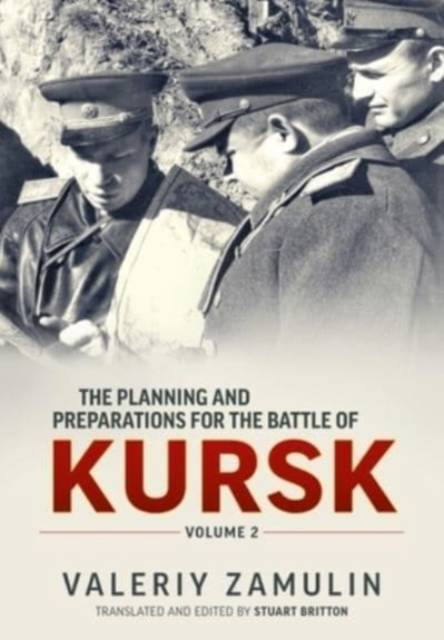
- Retrait gratuit dans votre magasin Club
- 7.000.000 titres dans notre catalogue
- Payer en toute sécurité
- Toujours un magasin près de chez vous
- Retrait gratuit dans votre magasin Club
- 7.000.000 titres dans notre catalogue
- Payer en toute sécurité
- Toujours un magasin près de chez vous
The Planning and Preparations for the Battle of Kursk
Volume 2
Valeriy Zamulin
Livre broché | Anglais
52,45 €
+ 104 points
Format
Description
Volume 2 is devoted to the preparation by Moscow of hostilities near Kursk in the spring and early summer of 1943 and consists of two parts. Part I analyzes the activities of the Stavka B of the Air Command, the General Staff of the Red Army, the command of the Central and Voronezh fronts to restore troops after the battles in the winter of 1942-1943 and their strengthening before the summer campaign. All events in the north and south of the Kursk Bulge are considered in parallel, in strict chronological sequence, which allows the author to provide a detailed account of the preparation for the Battle of Kursk.
One of the most interesting and important sections of the first part is devoted to the analysis and assessment of the level of professional training of the senior and higher command levels of the Central and Voronezh fronts. The difficult situation in the leadership of the 70th and 48th armies of the Central Front, which developed in the spring of 1943, is examined in detail, as well as the socio-demographic data and professional qualities of the commanders of the rifle divisions that formed the basis of the fronts defending the Kursk arc. For the material for this section the author not only collected materials from Russian archives and museums, but also amongst the families of the officers throughout Russia and in the republics of the former USSR. This section also provides a significant array of recently declassified statistical data on the state of the formations of the three main branches of the armed forces (rifle, tank and artillery) of the Central and Voronezh fronts and their defense at the beginning of the battles.
In the second part the author describes the Red Army's planning in the area of the Kursk salient in late June - early July 1943, and also considers the major problems that arose for them during this period. This part links together material presented in both volumes. In it, for the first time, unknown documents of the contending forces, are discussed in detail. There is detailed coverage of the work carried out by the headquarters of the Central and Voronezh fronts in late June - early July to determine the date and time of the beginning of the offensive of the German troops, was analyzed.
In the preparation of both parts of Volume 2 a complex array of recently declassified Soviet documents, including operational material of brigade or divisional headquarters were used, along with additional archival sources and memoirs of the participants.
At the same time, in order to answer a number of important questions that have been actively discussed by Russian and Western historians in the postwar period, the author utilises a wide range of captured German sources from the US National Archives, which allow us to not only expand our understanding of those events, but to clarify a number of facts and details, and to provide a more balanced, reasonable assessment of the events that took place in the in the spring and early summer of 1943.
The book includes an appendix with significant statistical material, summarized in tables, which will help the reader to better comprehend what is stated in the text of the book. In addition, it is illustrated by rare photographs collected in domestic and foreign archives, in museums and private collections.
One of the most interesting and important sections of the first part is devoted to the analysis and assessment of the level of professional training of the senior and higher command levels of the Central and Voronezh fronts. The difficult situation in the leadership of the 70th and 48th armies of the Central Front, which developed in the spring of 1943, is examined in detail, as well as the socio-demographic data and professional qualities of the commanders of the rifle divisions that formed the basis of the fronts defending the Kursk arc. For the material for this section the author not only collected materials from Russian archives and museums, but also amongst the families of the officers throughout Russia and in the republics of the former USSR. This section also provides a significant array of recently declassified statistical data on the state of the formations of the three main branches of the armed forces (rifle, tank and artillery) of the Central and Voronezh fronts and their defense at the beginning of the battles.
In the second part the author describes the Red Army's planning in the area of the Kursk salient in late June - early July 1943, and also considers the major problems that arose for them during this period. This part links together material presented in both volumes. In it, for the first time, unknown documents of the contending forces, are discussed in detail. There is detailed coverage of the work carried out by the headquarters of the Central and Voronezh fronts in late June - early July to determine the date and time of the beginning of the offensive of the German troops, was analyzed.
In the preparation of both parts of Volume 2 a complex array of recently declassified Soviet documents, including operational material of brigade or divisional headquarters were used, along with additional archival sources and memoirs of the participants.
At the same time, in order to answer a number of important questions that have been actively discussed by Russian and Western historians in the postwar period, the author utilises a wide range of captured German sources from the US National Archives, which allow us to not only expand our understanding of those events, but to clarify a number of facts and details, and to provide a more balanced, reasonable assessment of the events that took place in the in the spring and early summer of 1943.
The book includes an appendix with significant statistical material, summarized in tables, which will help the reader to better comprehend what is stated in the text of the book. In addition, it is illustrated by rare photographs collected in domestic and foreign archives, in museums and private collections.
Spécifications
Parties prenantes
- Auteur(s) :
- Editeur:
Contenu
- Nombre de pages :
- 568
- Langue:
- Anglais
Caractéristiques
- EAN:
- 9781915070821
- Date de parution :
- 31-08-25
- Format:
- Livre broché
- Format numérique:
- Trade paperback (VS)
- Dimensions :
- 171 mm x 248 mm







